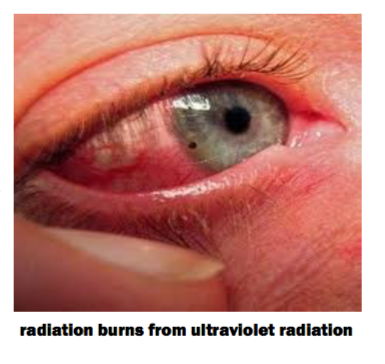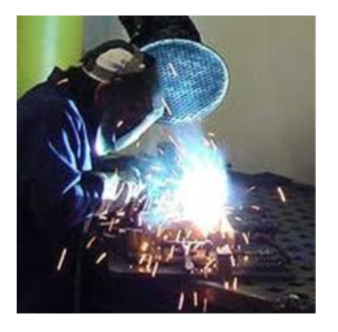Eye Safety First 100% of the time.
 Eye injuries account for one – quarter of all welding injuries, making them by far the most common injury for welders. The best way to control eye injuries is also the most simple: proper selection and use of eye protection. Helmets alone do not offer enough protection. Welders should wear goggles or safety glasses with side shields that comply with ANSI Z87.1 under welding helmets and always wear goggles or other suitable eye protection when gas welding or oxygen cutting. To help in reducing eye injuries, you should educate workers about all of the dangers they face and should implement an eye protection plan that outlines proper welding behavior. Damage from ultraviolet light can occur very quickly. Normally absorbed in the cornea and lens of the eye, ultraviolet radiation (UVR) often causes arc eye or arc flash, a very painful but seldom permanent injury that is characterized by eye swelling, tearing, and pain. While most welding related eye injuries are reversible, with more than half of injured workers returning to work in less than two days and 95 percent in less than seven days, some eye injuries are irreversible and permanent visual impairment occurs. This is especially true with infrared and visible spectrum (bright light) radiation. Both can penetrate through to the retina and — although this is rare — can cause permanent retinal damage, including cataracts, diminished visual acuity, and higher sensitivity to light and glare.
Eye injuries account for one – quarter of all welding injuries, making them by far the most common injury for welders. The best way to control eye injuries is also the most simple: proper selection and use of eye protection. Helmets alone do not offer enough protection. Welders should wear goggles or safety glasses with side shields that comply with ANSI Z87.1 under welding helmets and always wear goggles or other suitable eye protection when gas welding or oxygen cutting. To help in reducing eye injuries, you should educate workers about all of the dangers they face and should implement an eye protection plan that outlines proper welding behavior. Damage from ultraviolet light can occur very quickly. Normally absorbed in the cornea and lens of the eye, ultraviolet radiation (UVR) often causes arc eye or arc flash, a very painful but seldom permanent injury that is characterized by eye swelling, tearing, and pain. While most welding related eye injuries are reversible, with more than half of injured workers returning to work in less than two days and 95 percent in less than seven days, some eye injuries are irreversible and permanent visual impairment occurs. This is especially true with infrared and visible spectrum (bright light) radiation. Both can penetrate through to the retina and — although this is rare — can cause permanent retinal damage, including cataracts, diminished visual acuity, and higher sensitivity to light and glare.
As a general rule, select filter shades or lenses beginning with a shade too dark to see the welding zone. Then evaluate a lighter shade that provides adequate vision without going below the minimum protective shade. Most protective eyewear manufacturers offer 2.0, 3.0, and 5.0 filter shades, which protect against harmful optical radiation generated when working with molten metal, cutting, soldering, and brazing. A filter shade 2.0 lens allows 29 – 43 percent of light to be transmitted, filter shade 3.0 lenses allow 8.5 – 18 percent of light to be transmitted, and filter shade 5.0 lenses allow 1.8 – 3.6 percent of light to be transmitted. These shades are available in protective eyewear, goggles, and welding helmets.

To avoid ultraviolet skin burns protective clothing must be worn. The selection process for the most appropriate protective clothing for various welding and cutting operations will vary with the task size and location of the work to be performed. By carefully examining which hazards are possible, new technologies will often provide greater comfort, which can improve employee acceptance and increase wearing of the proper protective apparel.
WELDING FUMES
 Welding fumes are very small particles that are formed when the vaporized metal rapidly condenses in air. They are typically too small to be seen by the naked eye but collectively form a visible plume. The health effects associated with metal fumes depend on the specific metals present in the fumes; they may range from short-term illnesses, such as metal fumes fever (i.e., flu-like symptoms), to long term lung damage and/ or neurological disorders. If the metal has been degreased with chlorinated solvent, other airborne gases (such as phosgene, hydrogen chloride, chlorine gas, etc.) maybe produced. These gases generally cause irritated eyes , nose and respiratory system, and symptoms may be delayed. Always read the Material Safety Data Sheets supplied with the material you are using. These MSDSs will provide information regarding the kind and amount of fumes as gases that may be dangerous to your health. Fume extraction is the best way to remove dangerous fumes from your welding environment. There are many fume extractors on the market to choose from.
Welding fumes are very small particles that are formed when the vaporized metal rapidly condenses in air. They are typically too small to be seen by the naked eye but collectively form a visible plume. The health effects associated with metal fumes depend on the specific metals present in the fumes; they may range from short-term illnesses, such as metal fumes fever (i.e., flu-like symptoms), to long term lung damage and/ or neurological disorders. If the metal has been degreased with chlorinated solvent, other airborne gases (such as phosgene, hydrogen chloride, chlorine gas, etc.) maybe produced. These gases generally cause irritated eyes , nose and respiratory system, and symptoms may be delayed. Always read the Material Safety Data Sheets supplied with the material you are using. These MSDSs will provide information regarding the kind and amount of fumes as gases that may be dangerous to your health. Fume extraction is the best way to remove dangerous fumes from your welding environment. There are many fume extractors on the market to choose from.
ELECTRIC SHOCK
The human body conducts electricity. Even low currents may cause severe health effects. Spasms, burns, muscle paralysis, or death can result depending on the amount of the current flowing through the body, the route it takes, and the duration of exposure.
If a person touches a live conductor, current may flow through the body to the ground and cause a shock. Increased electrical contact with the weld ground increases the risk of shock. Avoid standing in water, on wet surfaces, or working with wet hands or wearing sweaty garments. Small shocks could surprise you and cause you to slip and fall, possibly from a high place.
What should I do in case of electric shock?
Call for medical help. DO NOT touch the victim with y o ur “bare hands” until he or she is away from the live electrical source. Turn off the power at the fuse box or circuit breaker panel if an appliance or electrical equipment is the electrical source or, if you can do it safely, turn off the appliance or electrical equipment and unplug it. Just turning off the equipment is not sufficient. If the electricity cannot be turned off and the victim is still in contact with the electrical source, decide if you must move the victim or push the wire away from the victim (call for emergency help if the wire is a high voltage power line). Insulate yourself if you must move a victim away from a live contact – wear dry gloves or cover your hands with cloth and stand on dry insulating material like cardboard, wood or clothes. Ensure you have good footing and will not slip or fall when trying to move the victim. Do not move the victim if there is a possibility of neck injury (from a fall, for example) unless it is absolutely necessary. Give artificial respiration if the victim is not breathing. Give CPR if the victim’s heart has stopped (only if you are trained in CPR).
